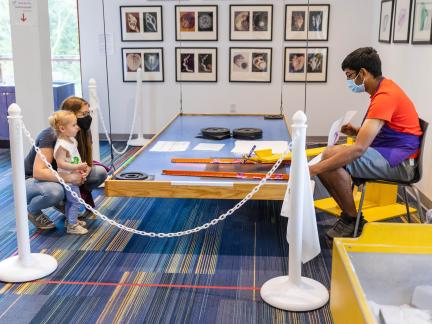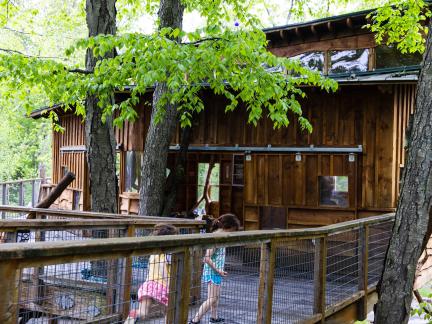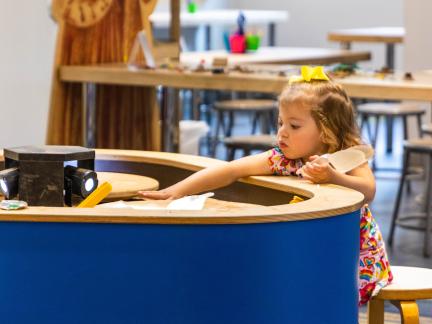Just Right Risks
I am trying to look calm and cool on the outside but inside, my heart is pounding. “Watch this, momma!” my 4-year-old daughter squeals as she swings from a branch and just barely catches the boulder with her feet. Thankfully, as the Outdoor and Environmental Educator at the Discovery Museums, I’ve read lots of research about the benefits of healthy risk-taking in play. I repeat all the benefits to myself in my head to keep from panicking as my daughter grunts and finally pulls herself up onto the top of the boulder—barely avoiding falling on her head!
It’s one of the hardest things I’ve had to do as a mother: bite my tongue when I want to call out, “Be careful! You don’t want to fall!” Our instincts to protect our children are innate and essential, but allowing our children to take healthy risks as they explore the outdoors is also vital to their bodies and minds.
At the Museums, I regularly take families on walks through the Great Hill Conservation land that surrounds our property. Children are natural explorers. They climb and run and dig without hesitation. Parents, on the other hand, may hold back—and may hold back their kids—in the name of safety.
It’s no surprise that we, as adults, worry about our children when they are in nature. We live in an increasingly urban and sedentary culture. Unstructured outdoor play often loses out to scheduled activities, academic pressures, and screen time. We’ve developed an exaggerated notion of the dangers our children face when they head outside to play. What’s sacrificed is the opportunity for kids to take healthy risks such as jumping off a rock, touching a worm, or turning over a log to see what lives underneath.
The benefits of allowing children to take risks are clear. Not only does it allow kids to learn and grow physically, but it also develops their minds. They learn for themselves how to judge safety and make decisions. In fact, research has shown that children who engage in this type of play are more likely to abstain from truly dangerous behaviors. Conversely, when children are overly protected they will participate in more intense and unsafe activities when given the choice.
The skills children learn when they are allowed to take risks carry over into all aspects of their lives. Studies have shown that risk-taking can lead to improved self-confidence and creativity. These children are also more willing to take risks in the classroom because they aren’t afraid to make mistakes, another key ingredient to learning.
What’s great is that promoting this type of play is easy. Children do it all on their own when we let them. Nature is such an easy place to provide opportunities for healthy risk taking—no setup required!
My daughter moves to the edge of the boulder as if she’s thinking of jumping off. I think this might be the limit and I’m about to speak up when she says, “That’s a long way down, can you help me?”
For more information, the following article provides a good overview of the research on risk taking in childhood: Little, H., Wyver, S., (2008). Outdoor play — Does avoiding the risks reduce the benefits? Australian Journal of Early Childhood, 33(2), 33-40.






Comments
Add new comment